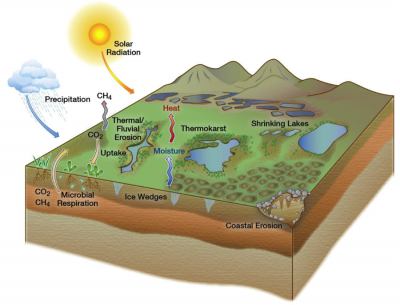The Department of Energy (DOE) has developed a new accelerated approach to climate change research called Next-Generation Ecosystem Experiments (NGEE). This strategy seeks to provide Earth System Models (ESMs) with improved representation of climatically sensitive and globally important ecosystem processes. Supported by the Terrestrial Ecosystem Science program within DOE's Office of Biological and Environmental Research, NGEEs connect modeling and field studies in an iterative approach so that model needs are considered in development of field studies whose outcomes in turn inform and improve the models. The first NGEE project, entitled NGEE Arctic Landscapes, studies ecosystems undergoing permafrost thaw. Future NGEE projects will target other ecosystems such as the tropics.

The NGEE Arctic Landscapes project aims to advance predictive understanding of the structure and function of arctic terrestrial ecosystems in response to climate change. Efforts focus on understanding how thawing permafrost and the associated changes in landscape evolution, hydrology, soil biogeochemical processes, and plant community succession affect feedbacks to the climate system. Ultimately NGEE Arctic Landscapes will develop a high-resolution ecosystem model of the arctic tundra as it evolves in response to climate change.
NGEE Arctic Landscapes is designed as a ten-year project. Phase 1, an initial three years of work in Barrow, Alaska, is now in its second year. The team has established and instrumented field sites near the Barrow Environmental Observatory. Initial research has focused on hydrology, vegetation, and carbon cycle dynamics across polygonal landscapes. Ground penetrating radar, electrical resistivity, and other geophysical techniques have been used by Susan Hubbard and her team from Lawrence Berkeley National Laboratory to characterize subsurface properties of ice-rich polygonal landscapes, including detection of ice wedge size and distribution. Permafrost cores to a depth of several meters have been obtained and returned to Oak Ridge and Lawrence Berkeley National Laboratories for analysis, including determining carbon emissions and their relationship to the composition of the microbial community.
Alistair Rogers, a plant physiologist at Brookhaven National Laboratory, has measured leaf photosynthesis for plants growing on the arctic tundra. Rogers and others have compared these measurements to estimates used in climate models. Discrepancies in how climate models represent vegetation carbon uptake from the atmosphere suggest that improvements to models can be made fairly quickly in this specific area of research. Geophysical information on ice wedge size and distribution is being used to parameterize fine-scale models of permafrost thaw and degradation and evolution of arctic landscapes. Vladimir Romanovsky at University of Alaska Fairbanks is contributing to new model development in this effort. Additional funding for Phase 2 will expand work to other areas in northern Alaska.
NGEE Arctic Landscapes is a collaborative effort led by Oak Ridge National Laboratory, which includes scientists at Los Alamos National Laboratory, Brookhaven National Laboratory, Lawrence Berkeley National Laboratory, University of Alaska Fairbanks, and partners at other universities and federal agencies. Additional DOE programs contributing to this project include the Atmospheric Radiation Measurement Climate Research Facility, Atmospheric System Research program, Genomic Science program, and Climate and Earth System Modeling program.
The established field site in Barrow, Alaska offers collaboration opportunities for scientists conducting complementary research and the project website has a mechanism for other scientist to request soil, water, and plant samples. Funding opportunities for proposals specifically related to the NGEE Arctic Landscapes project, such as recent DOE Terrestrial Ecosystem Science program solicitations, may continue.
While the NGEE Arctic Landscapes project is committed to supporting the development of a process-rich land surface model for incorporation into advanced high-resolution climate models, realizing this goal can only be achieved by establishing strong international partnerships. Multiple international programs are addressing critical feedbacks between land surfaces and atmosphere in high-latitudes ecosystems [(e.g., The Arctic Boreal Vulnerability Experiment (ABoVE), Carbon in Arctic Reservoirs Vulnerability Experiment (CARVE), and Changing Permafrost in the Arctic and its Global Effects in the 21st Century (PAGE21)]. Participants in the NGEE Arctic Landscapes project are planning to work with others in the community to identify opportunities for collaboration. Systematic sampling strategies and a common framework for scaling are essential for understanding ecosystem responses to climate change and informing models. In the harsh arctic environment, where climate change appears to be most rapidly affecting vulnerable, carbon-rich permafrost, filling critical gaps in observations is expensive and technically challenging, and must be strategically developed. Although the NGEE Arctic Landscapes project is currently conducting initial research in Barrow, Alaska, it has plans to include other sites in Alaska. This expansion will seek to encompass a unique set of permafrost investigations performed at field sites that span multiple bioclimatic zones. The challenges of understanding and accurately simulating the changes occurring in the arctic ecosystem, climate, and landscape are tremendous, but this goal can be achieved through coordinated partnerships amongst arctic researchers throughout the world.
For further information about the NGEE Arctic Landscapes project, see the NGEE - Arctic website or contact Stan D. Wullschleger (wullschlegsd [at] ornl.gov) or Larry Hinzman (lhinzman [at] iarc.uaf.edu).
Many thanks to Stan D. Wullschleger, of Oak Ridge National Laboratory, and Larry Hinzman, of the International Arctic Research Center, for their contributions to this article.
